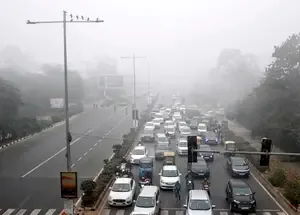Air Quality in Delhi Remains 'Very Poor', IMD Predicts Cloudy Weather

Synopsis
Key Takeaways
- Delhi's AQI is at 313, categorized as 'very poor'.
- IMD has issued a yellow alert for dense fog.
- Weather forecast includes cloudy conditions and light rain.
- Areas like Anand Vihar and Vivek Vihar report alarming AQI levels.
- Health precautions are crucial due to ongoing pollution.
New Delhi, Feb 3 (NationPress) The air quality in Delhi continues to be categorized as ‘very poor’, with the Air Quality Index (AQI) measuring at 313 early Monday morning, as reported by the Central Pollution Control Board (CPCB).
The Indian Meteorological Department (IMD) has issued a yellow alert for severe fog in the capital, cautioning residents about potential disruptions due to low visibility. Cloudy weather coupled with light rain or drizzle is anticipated over the next few days.
In recent days, there has been a significant spike in AQI levels, indicating a deteriorating trend. This rise in pollution is caused by a mix of adverse meteorological conditions.
As of Monday morning, several regions in Delhi are reporting concerning AQI levels. Anand Vihar recorded an AQI of 357, while Ashok Vihar was at 335. Other areas, including Jahangirpuri, Punjabi Bagh, Patparganj, and Wazirpur, also saw AQI values between 322 and 347.
Notably, Vivek Vihar recorded the highest AQI at 359, showcasing the severity of air quality issues in the capital. Locations like R K Puram, Chandni Chowk, and Najafgarh also reported AQI figures exceeding 300, reinforcing their classification in the ‘very poor’ category.
Key factors contributing to the declining air quality include stagnant winds, fluctuating wind directions, smog, and lower mixing heights. Furthermore, a thick layer of fog blanketed parts of Delhi on Monday morning, exacerbating the critical situation and trapping pollutants, thereby worsening air quality.
The change in weather patterns is linked to an active meteorological disturbance. According to IMD predictions, temperatures in Delhi will range from 22 degrees Celsius during the day to 9 degrees Celsius at night.
In the coming days, the Air Quality Early Warning System for Delhi forecasts that AQI levels will persist in the ‘very poor’ category, particularly from February 3 to 4.
The ongoing pollution levels are likely to impact the health and well-being of residents, making it imperative to stay updated and take necessary precautions.







